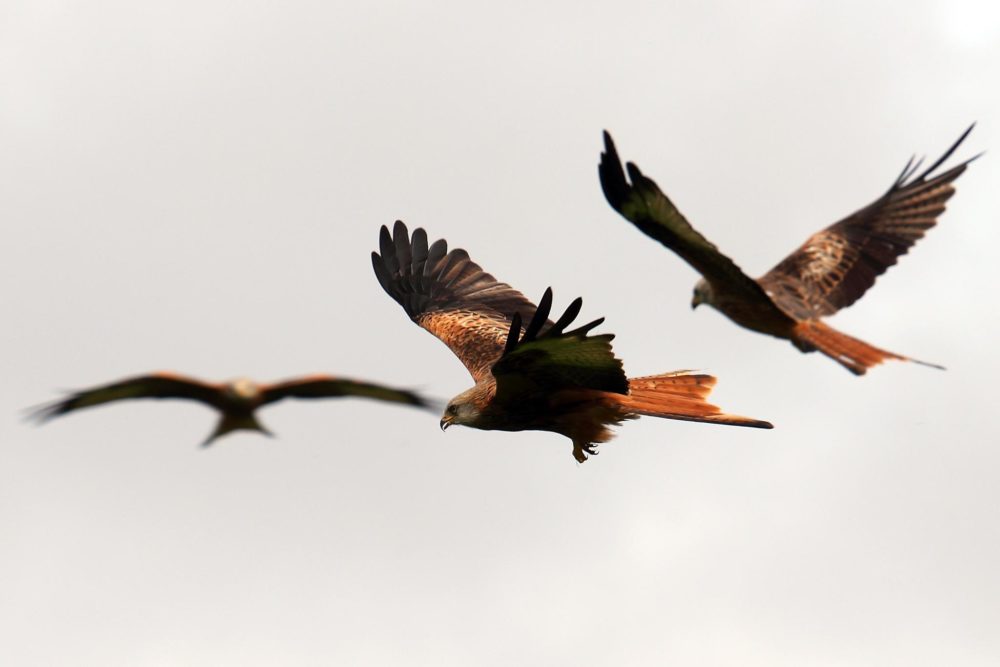More onshore wind farms in Wales unlikely to halt red kite recovery – study

Developing more onshore wind farms in Wales is unlikely to stop the recovery of the country’s red kite population, research suggests.
A study carried out to assess the impact of the onshore wind schemes planned across the Welsh landscape on the birds of prey found numbers would likely continue to increase, though the rate of growth might slow.
Red kites, birds of prey that mostly feed on carrion, were once widespread but declined in the face of persecution to become extinct in Scotland and England by the late 19th century, while just clinging on in mid-Wales with a few pairs.
Population increase
Numbers remained low until starting to recover over the last three or four decades, and there are now around 2,000-2,500 pairs in Wales, with the population continuing to increase.
Meanwhile reintroductions in England and Scotland have seen the birds return to swathes of Britain.
But with plans for more onshore wind farms in the pipeline in Wales, concerns have been raised over the impact the turbines – which can kill birds that collide with their blades – could have on the recovering population in the country.
A study led by the British Trust for Ornithology (BTO) and BSG Ecology, funded by industry body RenewableUK Cymru, modelled the potential impacts of current and proposed wind farm developments, including those at an early stage, on the Welsh population of red kites.
The analysis found that while commissioning the suite of wind farm projects currently in development might slow down the growth in the numbers of red kites, it was very unlikely to lead to national population declines in Wales.
High turbine density
But impacts were more likely in areas of high turbine density, which is relevant to two special protected areas (SPAs) that have been designated because of their red kite populations.
The study said “greater caution” is justified for developments close to those areas, to minimise risk to their high density populations of red kites.
Callum Macgregor, senior research ecologist for the BTO and study author, said: “There’s fairly good data that not many red kites get knocked out of the sky by wind farms, and most of them are quite good at seeing wind turbines and flying round them, though not all.”
But he added: “Given the history of the species in Wales, there’s understandably a precautious approach to anything that might harm that recovery.
“That’s where the concern comes from, if red kites do occasionally fly into turbines and are killed by them, what does that mean for the red kite population in the long term if we start putting them in?”
The study modelled survival and productivity rates for red kites, comparing them to what was known about the population in Wales from conservation surveying to assess which models were likely to apply in the country.
It made estimates for changes in survival rates that could occur if more wind farms were put in the landscape.
Slow growth
Dr Macgregor said the study found “building these future wind farms that are in various stages of development will probably slow the growth (in red kite numbers), but it’s not likely to slow it down so much that you end up with the population stabilising or declining”.
In the Elenydd-Mallaen SPA in mid-Wales where there is a high density of red kites, there was a small (4%) possibility of the population declining if all planned wind farms were built, he added.
He said there was reason for decision-makers to continue to think about the SPAs in developing wind farms, but he said: “Our results do not lead to a great deal of concern around the SPAs, though slightly more concern than for the population at national scale.”
Owain Gabb, director at BSG Ecology, said “It has been a pleasure to see the openness of the renewables industry in Wales to engaging with this project.
“The study demonstrates that with appropriate consideration at the design stage, wind farms are unlikely to affect Welsh red kite populations at the regional or national level, which is a very positive outcome.”
Support our Nation today
For the price of a cup of coffee a month you can help us create an independent, not-for-profit, national news service for the people of Wales, by the people of Wales.








“….funded by industry body RenewableUK Cymru, ” Say no more. I wonder how much of a donation it took to fix that report?.
It always pays to look who funds these types of studies.
interesting timing, with so many DNS applications. We weren’t all born yesterday.